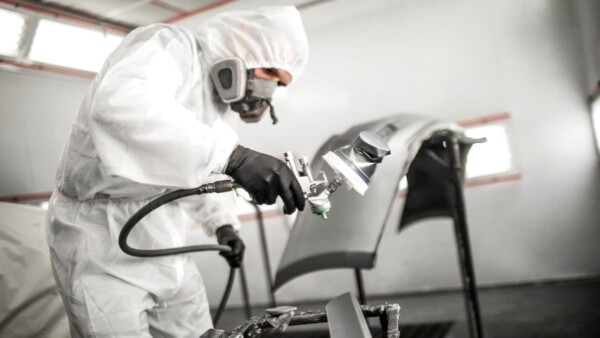Reduction of atmospheric pollution in the painting and coating sector
Technological systems for the abatement of fumes, VOC and dust from painting and coating operations

The industrial painting sector includes many companies that perform different processes, such as: powder and spray coating, coating and galvanic treatments
Many of these industrial processes involve the emission of pollutants more or less harmful to the environment and to operators, for this reason they must be extracted and treated using special technologies.
Technologies for the abatement of atmospheric pollution deriving from the production and use of paints and similar products
Paints are chemical mixtures composed of solvents, plasticizers and components with adhesive characteristics. They are applied to different materials (metals, plastics, paper, wood and much more) in order to protect the surface from external agents and/ or customise the products aesthetically.
As you can imagine, paint production and laying and coating operations involve the emission of pollutants that quickly spread into the workplace and the atmosphere. In order to avoid the harmful effects of this situation, companies must:
- provide operators with Personal Protective Equipment (safety goggles, gloves, headgear and breathable waterproof overalls to safeguard the whole body from contact with harmful substances;
- have special installations for the extraction and abatement of pollutants, in compliance with current environmental regulations.
The technologies that can be used for this purpose are multiple and their application varies depending on the pollutants present. Among the main substances emitted in the painting and galvanic sector, we have:
- VOC resulting from the production of paints and from spraying and operations;
- Dust emitted during sanding, sandblasting and powder coating operations;
- Chemical fumes and vapours from coating operations
Let’s take a look together at some concrete cases in which Tecnosida® plants have solved the problems of clients operating in the painting & coating sector!
VOC abatement from spray painting
Spray painting is used by many companies to cover different types of materials. This process involves the emission of dust and VOC that must be treated through special filters and purifiers.
Paints used in this process have different characteristics and, depending on their composition, can be explosive or non-explosive in nature. In order to design and implement a suitable extraction and treatment system, it is important to know this data because if such explosive dust is present, an ATEX system must be implemented.
The nature of the dust is usually indicated on the paint safety data sheet. In the absence of this information, special analyses must be carried out on a dust sample.
Dust and VOC abatement from methacrylate production and execution of protective coatings
The painting & coating sector not only includes companies that carry out painting operations, but also all those enterprises that deal with paint production.
The market offers different types of paint. Each is formed by different components whose processing involves the emission of specific pollutants..
The production of methacrylate and thermal spray coatings (a coating used in many industrial applications to provide protection against corrosion), involves the emission of titanium dioxide and calcium carbonate powders which must be abated before emission in the work place and the atmosphere.
Protective coatings: VOC emissions oxidation
In the automotive sector, vehicles are manufactured that are widely used in our daily lives. The production of these vehicles involves a whole series of components being manufactured that are protected by special coating operations. These processes involve the emission of fumes and VOC that can be oxidised through special technologies.
Reduction of atmospheric pollution in the painting sector
In the previous sections, we presented an overview of the most common pollutants in the painting & galvanic sector and technologies to reduce them.
The latter are multiple and the scope varies depending on the characteristics of the pollutants and the production system used.
For this reason, it is necessary to rely on professionals who can assess the existing conditions and propose suitable systems for extraction and abatement to solve the various problems.
Tecnosida®, thanks to its vast experience in the field, is the ideal supplier for the design and implementation of tailor-made systems to adapt emissions to the limits set by current regulations.
Contact us for personalised support: we will design and build the most suitable system for your business needs!